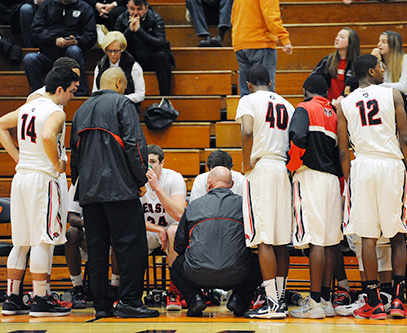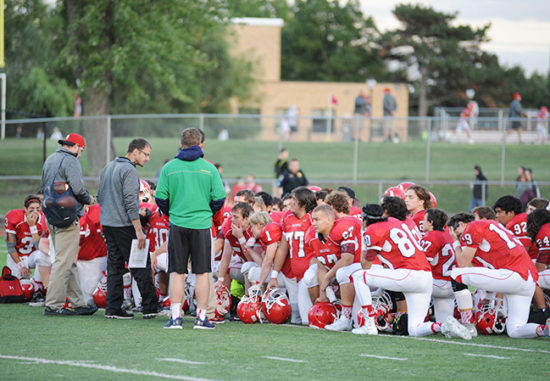10 steps to correct a problematic program
If you find yourself faced with the daunting task of resuscitating and resurrecting a problematic program, you obviously have a big challenge on your hands. You likely need to make some major overhauls to your programs talent, culture, attitude, commitment, chemistry and team leadership. That is a lot to do, but the key is to break it down into a manageable process and prioritize.
 Through it all, keep in mind that it has been done before. Jim Harbaugh transformed the San Francisco 49ers, Tom Crean resurrected the Indiana men’s basketball program and Nick Saban brought Alabama football back to national prominence and dominance. You need a strong passion and a solid plan to make it happen.
Through it all, keep in mind that it has been done before. Jim Harbaugh transformed the San Francisco 49ers, Tom Crean resurrected the Indiana men’s basketball program and Nick Saban brought Alabama football back to national prominence and dominance. You need a strong passion and a solid plan to make it happen.
1. See it.
Many problems occur because people fail to see them. Some coaches aren’t consciously aware of the quantity or severity of the problems until it is too late. They aren’t tuned into the early warning signs of team turmoil and then suddenly are blindsided by them. Other coaches may see the problems brewing, but aren’t willing to admit to their severity. They try to ignore the incendiary issues thinking they will die out on their own. This wait-and-see approach often contributes to their program going up in flames.
Seeing your problematic situation as it truly is marks the first step to turning things around. You must honestly understand the real issues before you are able to solve them. This is no time for sugarcoating. You need to seek the unvarnished truth.
Have the courage to ask the difficult question, What is it that I probably don’t want to hear, but need to hear? Be sure not to shoot the messengers when you ask them. Accept the answers and thank people for their candor. You desperately need their honesty to get to the truth.
To fully assess the extent of your situation, seek a variety of input.
The most insightful sources of feedback are often the most overlooked, says business coach Marshall Goldsmith. Valuable sources include those people who have known us for a long time. They include those who have worked with us and for us over time and our families. All these people will have held a long-term, unadulterated and unvarnished view of us. They can provide a wealth of feedback and coaching for usif only we have the courage to tap into their knowledge.
2. Own it.
Once you completely understand the situation and its root causes, the next step is to own it. That means taking full responsibility for whatever situation you might find yourself in. In some cases, the predicament or crisis may not even be your fault if you are new to the situation, but it is still your problem. Owning it means that you will hold yourself fully accountable for improving and fixing it.
 For example, I worked with a college women’s basketball team that was having major issues between the coaches and the players. I met separately with both groups to try to better understand the situation. Each side blamed the other for their frustrating season and dysfunctional culture. The coaches felt like the athletes didn’t buy into their system or try hard enough to make it work. The athletes, on the other hand, felt like the coaches didn’t really understand or care about them as people.
For example, I worked with a college women’s basketball team that was having major issues between the coaches and the players. I met separately with both groups to try to better understand the situation. Each side blamed the other for their frustrating season and dysfunctional culture. The coaches felt like the athletes didn’t buy into their system or try hard enough to make it work. The athletes, on the other hand, felt like the coaches didn’t really understand or care about them as people.
I asked the coaches, “How much of the problem is your athletes and them not doing what you need them to do?” The coaches felt like the athletes were 90 percent of the problem.
I then asked the athletes, ”How much of the problem is due to your coaches?” As you might guess, the athletes felt like the coaches were 90 percent of the problem. It was much easier for both groups to blame the other for the issues, rather than looking inwardly and taking ownership for their part.
I reminded both groups that not much was going to be accomplished if they continued to blame the other side. I then challenged them to take full responsibility for what they were doing to contribute to the problems, even though in their minds it was only 10 percent of the problem.
Both groups made a full commitment to improve their 10 percent of the situation, when in actuality it was likely 50 percent of the problem. By taking ownership of their portion, the groups made the strides necessary to come together and salvage the season.
3. Solve it.
Find viable solutions to the problems your program faces. Keep in mind Albert Einsteins famous quote, The significant problems we face cannot be solved at the same level of thinking we were at when we created them. So you will need to think differently and make some changes.
A great exercise to generate solutions to a problem is one called Start/Stop/Continue. Simply ask your team and coaching staff to individually respond to the following questions:
- To get our team back on track we need to start
- To get our team back on track we need to stop
- To get our team back on track we need to continue
Compile all the responses and look for themes. This exercise should not only help you pinpoint the problems but, more importantly, generate some workable solutions. Discuss the insights and solutions with your team, prioritize the most helpful comments and decide on a course of action that you collectively think will work best.
4. Do it.
When you have a problematic program on your hands you can’t just talk about change and improvement. You and your team must fully commit to invest the necessary hard work to make it happen.
So many athletes and coaches talk a good game, but when it comes right down to it, they fail to follow through and act. Talk is cheap and change is hard. You must make a full commitment to implementing the change process. Process is the key word when it comes to turning things around. There will be some steps forward and others backward. Keep in mind that resurrecting a team is not an overnight process. Climbing out of a significant hole takes time, especially if it is a deep one.
Set up regular checkpoints (bi-monthly or monthly) to monitor your progress. Involve your key leaders to get their insights and feedback. Acknowledge the highlights and successes you achieve along the way, and make adjustments when you hit challenges or roadblocks.
You must sustain the change over time. Put in systems that reinforce and support the kinds of attitudes, chemistry, commitment and culture you need to be successful. Stay on top of things and listen to your leaders. Diligently guard against the problems that hurt your program in the first place. Be careful not to slip back into old habits.
5. Change the culture.
A big part of resurrecting a problematic program is changing the culture. You must re-engineer your program to create an environment of high expectations and mutual accountability. Send a clear message to your athletes about your vision, values, expectations and standards of behavior. Let them know what is accepted in your program and what will not be tolerated.
6. Change the mindset.
Rather than a mindset of negativity and hopelessness, you must work hard to change the mindset to one of positivity and hope. It all starts with you as a coach. Make sure you and your coaching staff model the mindset you want to see from your athletes. Bring a tone of energy, enthusiasm and focus to your workouts and practices. Positively call out the players who demonstrate the kind of attitude you need to be successful.
 7. Change the look.
7. Change the look.
To help your athletes really see and feel change, do whatever you can to revitalize and improve the look of your program. Change the paint color of your facilities to give them a fresh look. Put up new pictures. Change your website. Change your uniforms. Do what you can to let people know that things will be different. Even though the outward changes might be external and superficial at first, they send a clear signal to others that things are different.
8. Change the schedule.
If possible, alter your schedule to help your program gain some confidence and re-establish itself. You don’t need to load up on cupcakes but you also shouldn’t face a gauntlet of powerhouse teams. Arrange your schedule so you can gain some confidence early and get yourself and your program back on solid ground.
9. Consider staff changes.
When a program is struggling, some athletic directors tell their coaches that they need to change their assistant coaches. Former Florida State University football coach Bobby Bowden writes about this in The Bowden Way.
”An athletic director telephoned his head coach one morning and asked for a meeting,” Bowden writes. ”The season had gone poorly, the AD explained, and changes would need to be made. Two assistant coaches were singled out for blame. By innuendo, the coach was being told to fire them. Upon leaving the ADs office, the head coach called his staff together to explain the situation. He disagreed with the ADs assessment and said that firing two coaches would be wrong. Yet going against the ADs instructions might cause worse problems.
“This meeting became quite intense as each man pondered his future. Then the head coach shared his decision. From his point of view, every coach had done what was asked of him. No assistant had been derelict in his duty or disloyal to his superiors. Consequently, no one would be fired. They would stick together and aim for a better record next year.”
Changing your staff is never an easy decision. As Bowden says, if your coaches have not adequately performed their duties or have been disloyal to you, the decision is an easy one. If they are legitimately a contributing factor to why your program is struggling, you need to go in a different direction.
However, if your assistants are highly competent and effective and will be critical helping turn around the situation, you need to stick together and press forward.
10. Consider changing athletes.
When you coach a problematic program, you must strongly consider changing the makeup of your team, both in the short term and long term. From a long-term perspective, you obviously need to recruit and select the kind of talent, attitude, character and commitment necessary to build a winning program. Typically, problematic programs struggle because they did not recruit the right talent. Or, more likely, they have athletes with solid or spectacular talent but were deficient in the areas of attitude, character and commitment.
You may need to make some short-term changes in your personnel. Give people a chance to get on board with your new culture and mindset. Sell them on the vision of what is possible if they make a full commitment to improving your teams philosophy.
If they consistently and obstinately buck your system and refuse to get on board, you ultimately need to make the decision to remove them from your program, even if they are your most talented athletes. As tough as this may sound, remember that you are building for the long-term and can only do so by having the right people.
Resurrecting a problematic program is never easy. If you follow these 10 steps and trust your process, you too can transform a troubled program into a rising program.
For more practical tips and articles from Jeff Janssen, visit http://www.JanssenSportsLeadership.com.





